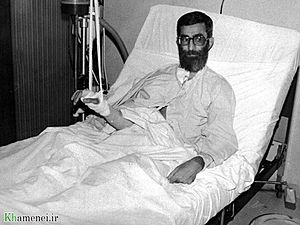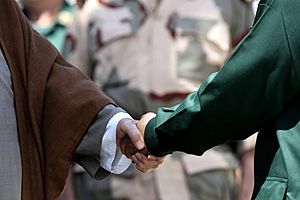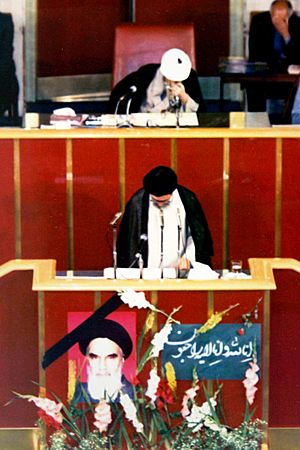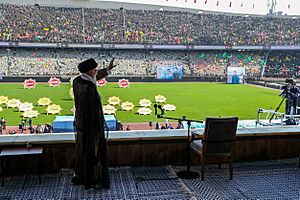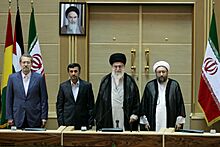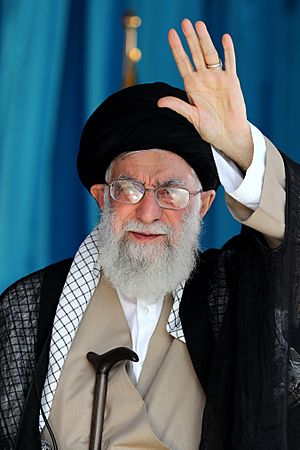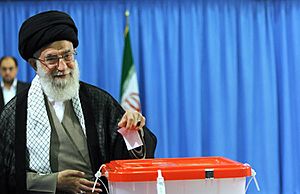Ali Khamenei facts for kids
Quick facts for kids
Ali Khamenei
|
|
|---|---|
|
علی خامنهای
|
|
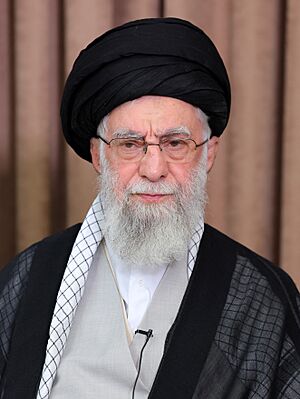
Khamenei in 2025
|
|
| 2nd Supreme Leader of Iran | |
| Assumed office 6 August 1989 |
|
| President | |
| Preceded by | Ruhollah Khomeini |
| 3rd President of Iran | |
| In office 9 October 1981 – 16 August 1989 |
|
| Supreme Leader |
|
| Prime Minister | Mir-Hossein Mousavi |
| Preceded by | Mohammad-Ali Rajai |
| Succeeded by | Akbar Hashemi Rafsanjani |
| 1st Chairman of the Expediency Discernment Council | |
| In office 7 February 1988 – 4 June 1989 |
|
| Appointed by | Ruhollah Khomeini |
| Preceded by | Office established |
| Succeeded by | Akbar Hashemi Rafsanjani |
| Member of the Assembly of Experts | |
| In office 15 August 1983 – 4 June 1989 |
|
| Constituency | Tehran Province |
| Majority | 2,800,353 (87.8%) |
| Member of the Islamic Consultative Assembly | |
| In office 28 May 1980 – 13 October 1981 |
|
| Constituency | Tehran, Rey and Shemiranat |
| Majority | 1,405,976 (65.8%) |
| Tehran's Friday Prayer Imam | |
| Assumed office 14 January 1980 |
|
| Appointed by | Ruhollah Khomeini |
| Interim Imams |
See list
Ahmad Jannati
Ahmad Khatami Kazem Seddiqi Ali Movahedi-Kermani Mohammad-Hassan Aboutorabi Fard Mohammad Javad Haj Ali Akbari |
| Preceded by | Hussein-Ali Montazeri |
| Personal details | |
| Born |
Ali Hosseini Khameneh
19 April 1939 Mashhad, Khorasan, Iran |
| Political party | Independent (1989–present) |
| Other political affiliations |
|
| Spouse |
Mansoureh Khojasteh Bagherzadeh
(m. 1964) |
| Children | 6 (including Mostafa, Mojtaba, and Masoud) |
| Parent |
|
| Relatives |
|
| Residence | House of Leadership |
| Education |
|
| Signature | |
| Military service | |
| Branch/service |
|
| Years of service | 1979–1980, 1980–1981 |
| Commands | Revolutionary Guards |
| Battles/wars |
|
| Religion | Islam |
| Denomination | Twelver Shiʿa |
| Religious career | |
| Teacher |
|
Ali Hosseini Khamenei (born 19 April 1939) is an important cleric and politician in Iran. He has been the second supreme leader of Iran since 1989. This means he has been Iran's top leader for 36 years. He is the longest-serving head of state in the Middle East. He is also the second-longest-serving Iranian leader of the 20th and 21st centuries.
Khamenei was born in Mashhad, Iran. He studied to become a religious scholar. He later became involved in opposing the Shah of Iran, Mohammad Reza Pahlavi. He was arrested several times for his actions. After the Iranian Revolution in 1979, he held many important jobs in the new government.
He was the third president of Iran from 1981 to 1989. During this time, Iran was in a war with Iraq. After the death of the first Supreme Leader, Ruhollah Khomeini, in 1989, Khamenei was chosen to be the new Supreme Leader.
As Supreme Leader, Khamenei has supported scientific progress in Iran. He has also supported Iran's nuclear program for peaceful uses. He has said that making weapons of mass destruction is forbidden by his religious beliefs. His foreign policy focuses on supporting groups he calls the "Axis of Resistance". He is known for supporting the Palestinians in their conflict with Israel.
Contents
Early Life and Education
Ali Khamenei was born on April 19, 1939. His father, Javad Khamenei, was a religious scholar. His mother was Khadijeh Mirdamadi. Ali was the second of eight children. Two of his brothers also became clerics.
Khamenei started his education at age four, learning the Quran. He studied at religious schools in Mashhad. Later, in 1958, he moved to Qom to study with important teachers like Ruhollah Khomeini.
Early Political Career
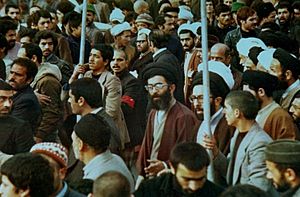
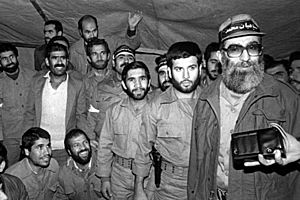
Khamenei was arrested six times before the Iranian Revolution. This was during the rule of Mohammad Reza Pahlavi. He was a key figure in the Iranian Revolution (1978–1979). He was a close helper of Ruhollah Khomeini.
After the revolution, Khamenei held many government jobs. In 1980, he became the Friday Prayers Imam in Tehran. He also worked as a deputy defense minister.
Assassination Attempt
On June 27, 1981, Khamenei was nearly assassinated. A bomb hidden in a tape recorder exploded near him. He was seriously injured and lost the use of his right arm.
Presidency (1981–1989)
In 1981, Khamenei was elected President of Iran. He won by a large number of votes. He was the first cleric to become president. He was reelected in 1985.
During his time as president, Iran was fighting the Iran–Iraq War. Khamenei was one of Iran's leaders during this war. He worked closely with the Islamic Revolutionary Guard Corps.
Supreme Leader (1989–Present)
In 1989, after Ruhollah Khomeini passed away, Khamenei was chosen as the new Supreme Leader. This decision was made by the Assembly of Experts.
As Supreme Leader, Khamenei has a lot of power. He makes final decisions on many important matters. These include the economy, foreign policy, and national plans. He also controls the military and media.
Political Approach
Khamenei has continued some of Khomeini's policies. He tries to balance different groups in power. This ensures that no single group becomes too strong. He has also built strong connections within the armed forces and among religious scholars.
Khamenei is seen as a very powerful leader. He issues decrees and guides various government bodies. He meets with officials and tells them what to do. He rarely travels outside Iran.
In his speeches, Khamenei often talks about the goals of the 1979 revolution. These include justice, independence, and opposing Israel and the United States.
Economic Policies
In 2007, Khamenei asked for state-owned companies to be sold to private owners. This included banks and oil companies. He wanted to speed up this process. He said that those who opposed these changes would lose their influence.
Financial Assets
Khamenei controls a large financial organization called "Setad." This organization manages a lot of money. It is said to be used for political purposes and to fund his office. However, Iranian officials say that Setad's profits are used for charity. They say the money helps poor regions, creates jobs, and builds schools and mosques.
Challenges and Protests

Khamenei has faced several protests during his time as leader. These include protests in 1999, 2009, 2011-2012, 2017-2018, and 2019-2020. People protested about various issues, including economic problems and government actions.
In 2009, after a presidential election, Khamenei firmly supported the results. He said that foreign powers were trying to cause trouble in Iran. He warned that Iran would respond strongly to any interference.
In 2023, there were more protests. Khamenei rejected calls for public votes on the country's future. He said that people's judgment could not always be trusted.
Relations with Former President Ahmadinejad
At first, Khamenei strongly supported President Mahmoud Ahmadinejad. But over time, they had disagreements. These disagreements were often about who should be in certain government positions. Khamenei sometimes stepped in to make final decisions.
In 2016, Khamenei advised Ahmadinejad not to run for president again.
Fatwas and Messages
Khamenei has issued religious rulings, called fatwas.
- Nuclear Weapons: He has reportedly issued a fatwa that says making, storing, or using nuclear weapons is forbidden in Islam. Iran has stated this at international meetings.
- Music Education: In 1996, he issued a fatwa saying that teaching music in schools goes against Islamic teachings. This led to some music schools closing.
- Fertility Treatments: In 1999, he issued a fatwa allowing the use of third-party donors in fertility treatments.
- Stem Cell Research: In 2002, he ruled that human stem cell research is allowed in Islam. This is permitted as long as it is used to create parts, not a whole human.
Khamenei also sends annual messages to Muslims during the Hajj pilgrimage. He encourages unity and warns against what he sees as "enemies' conspiracies."
Domestic Policy
Khamenei is the most powerful political figure in Iran. He is the head of state and the commander-in-chief of the armed forces. He makes the final decisions on major government policies.
He has direct or indirect control over all parts of the government. All candidates for important offices must be approved by a council. The members of this council are chosen by Khamenei. This gives him a lot of influence over who can run for office.
Khamenei has supported investing in science and technology. He believes this is important for Iran's progress. He also thinks that nuclear technology is vital for peaceful purposes.
Elections
Khamenei has a strong influence over elections in Iran. The Guardian Council, which he influences, approves or rejects candidates. This means he can affect who is allowed to run for president or parliament.
He has always taken a firm stance against protests related to elections. He insists that election results are accurate and legal.
Human Rights and Freedoms
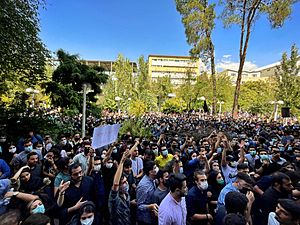
Khamenei's critics say he has overseen actions that limit human rights. However, Khamenei says that human rights are a key part of Islamic teachings. He criticizes Western countries for their own human rights records.
There have been many protests during his leadership. These include the 1999 Iranian student protests and the Mahsa Amini protests in 2022. During these protests, some people called for his resignation.
Minorities
The Baháʼí Faith is the largest religious minority in Iran. The Iranian government considers it a dangerous group. Khamenei has approved laws against Baháʼís. He has also ordered officials to monitor their activities.
Interaction with the Press
Khamenei has been criticized for limiting press freedom. In 2000, he stopped a law that would have allowed more press freedom. He said the existing law prevented problems.
Journalists and bloggers have been arrested for criticizing Khamenei. This is often linked to charges of insulting him.
Women's Rights
Khamenei has criticized women's rights activists in Iran. He believes that gender equality is a plan to harm the role of women in society.
He supports the Islamic practice of Hijab, which is a head covering for women. He believes it honors women. He argues that women in Western countries have lost their honor.
Foreign Policy
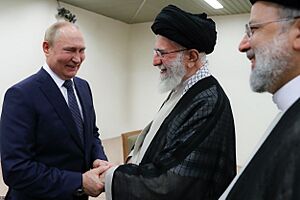
Khamenei has direct control over Iran's foreign policy. He has his own team that advises him on international matters. His foreign policy aims to avoid direct conflict but also not to fully cooperate with Western countries.
He has condemned actions by Saudi Arabia in Yemen. He also criticized the treatment of Rohingya Muslims in Myanmar. He has been criticized by the U.S. for not condemning human rights issues in China.
After the U.S. left the Iran nuclear deal in 2018, Iran has become closer to Russia and China. Iran has supplied drones to Russia for use in Ukraine. These actions have led some to speak of a new "Axis of Upheaval" involving Iran, Russia, China, and North Korea.
Views on the United States
Iran and the United States have not had formal diplomatic relations since 1980. Khamenei often speaks about opposing the United States. He has said that Iran needs the U.S. as an enemy.
In 2006, he warned that Iran would disrupt oil shipments from the Persian Gulf if attacked by the U.S. In 2007, he predicted that U.S. officials would be tried for the Iraq War.
In 2009, after U.S. President Barack Obama suggested a "new beginning," Khamenei said that words were not enough. He said Iran would watch and judge U.S. actions. He criticized U.S. foreign policy and interference in other countries.
In 2011, he accused the West of wanting Libyan oil during the military intervention there. He also accused the U.S. government of terrorism. In 2014, he claimed the U.S. and U.K. created ISIS to fight Iran.
In 2015, he said Iran's policy toward the U.S. would not change, even after the nuclear deal. In 2019, the U.S. placed sanctions on Khamenei. In 2020, he warned against U.S. aid for COVID-19, suggesting it could be harmful. In 2024, his social media accounts were removed for violating policies.
Views on Zionism and Israel

Khamenei is a strong opponent of the State of Israel and Zionism. He has been criticized for making threats against Israel. He has called Israel a "cancerous tumor" that should be removed.
He has said that Iran supports any groups fighting against Israel. He has also proposed that Palestinian refugees should return to their homes.
In 2015, he famously stated that "Israel will not exist in 25 years." This statement was widely reported. In 2017, he advised Islamic countries to focus on the issue of Palestine.
In 2020, Khamenei condemned the peace agreement between Israel and the United Arab Emirates. He said the UAE had betrayed the Islamic world.
2025 Iran–Israel War
In June 2025, Israel launched attacks on military and nuclear sites in Iran. This started the Iran–Israel war. Iran responded with missile and drone strikes on Israeli cities. The United States also took action, bombing Iranian nuclear sites. Iran then fired missiles at a U.S. base in Qatar. A ceasefire was agreed upon on June 24.
During the war, Khamenei was reportedly in a secure underground bunker. He was isolated from outside communication. He rejected calls for Iran to surrender. He also faced threats of assassination from U.S. and Israeli leaders.
After the ceasefire, Khamenei appeared in a recorded message. He warned the United States against future attacks. He declared victory over Israel and threatened more attacks on U.S. military bases. Some Iranian civilians expressed disappointment in Khamenei, calling him a "coward" for hiding. On July 5, 2025, Khamenei made his first public appearance since the war began.
Holocaust Denial
Khamenei has made statements that question the reality of the Holocaust. In 2014, he said that the Holocaust is an event whose reality is uncertain. He also noted that in Europe, questioning the Holocaust is considered a serious offense.
In 2016, he posted a video on his website that denied the Holocaust. In 2020, he tweeted asking why it is a crime to doubt the Holocaust, while insulting prophets is allowed.
Open Letters
Khamenei has written several open letters. In 2015, he wrote "To the Youth in Europe and North America". In 2024, he wrote a second letter to students at U.S. universities. He expressed support for their protests against Israel's actions in Gaza. He called them a "branch of the Resistance Front."
Personal Life
Family
Khamenei is married to Mansoureh Khojasteh Bagherzadeh. They have six children: four sons (Mostafa, Mojtaba, Masoud, and Meysam) and two daughters (Boshra and Hoda). His sons are married into other notable families. He has three brothers and one sister.
Home and Lifestyle
As Supreme Leader, Khamenei lives in a compound in Central Tehran. It has many buildings and employs hundreds of people.
He is known for living a simple life. His wife has said that their home does not have many decorations. He enjoys poetry and gardening. He is also known to have a good singing voice and plays the tar, a traditional Iranian instrument.
Health
Khamenei's health has been a topic of discussion. In 2014, he had prostate surgery. In 2015, some reports suggested he had prostate cancer. In 2022, he had surgery for a bowel issue.
Literature and Art
Khamenei has supported changes to the Persian language. He has also expressed views on art and literature.
In 1996, he issued a fatwa against music education for young children. This led to the closure of some music schools.
He believes that poetry and art can help spread the ideas of the Islamic revolution. He has shown interest in novels and stories since he was a child. He has praised works by authors like Victor Hugo, calling Les Misérables "a miracle." He also suggested reading The Grapes of Wrath and Uncle Tom's Cabin.
Khamenei is fluent in Arabic, Persian, and Azerbaijani. He has translated several books from Arabic into Persian. He also writes poetry under the name Amin.
Public Diplomacy
In 2011, Khamenei supported the Egyptian uprising. He called it an "Islamic awakening." He spoke in Arabic to Egyptian protesters. He has also praised Muslim youths in other countries for what he calls an "Islamic awakening."
In 2024, he wrote an open letter to American students. He described them as a new branch of the "Axis of Resistance." He encouraged them to learn about the Quran.
Works
- An Outline of Islamic Thought in the Quran
- Discourse on Patience
- Iqbal - Manifestation of the Islamic Spirit, Two Contemporary Muslim Views
- Replies to Inquiries about the Practical Laws of Islam
- Lessons from the Nahjul-Balaghah
- Human Rights in Islam
- The Charter of Freedom
- Essence of Tawhid: Denial of Servitude but to God
Translations from Arabic:
- Future in the realm of Islam.
Collections:
- A 250 Years Old Person
- Palestine
See also
 In Spanish: Alí Jamenei para niños
In Spanish: Alí Jamenei para niños
- Khamenei family
- Motto of years in Islamic Republic of Iran
- Islamic Government (book by Khomeini)
- Hibatullah Akhundzada



